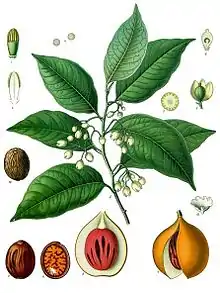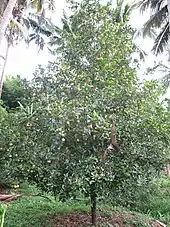Myristica fragrans
Myristica fragrans is an evergreen tree indigenous to the Moluccas (or the Spice Islands) of Indonesia. It is important as the main source of the spices nutmeg and mace.[2] It is widely grown across the tropics including Guangdong and Yunnan in China, Taiwan, Indonesia, Malaysia, Grenada in the Caribbean, Kerala in India, Sri Lanka and South America.[2][3]
| Myristica fragrans | |
|---|---|
 | |
| Scientific classification | |
| Kingdom: | Plantae |
| Clade: | Tracheophytes |
| Clade: | Angiosperms |
| Clade: | Magnoliids |
| Order: | Magnoliales |
| Family: | Myristicaceae |
| Genus: | Myristica |
| Species: | M. fragrans |
| Binomial name | |
| Myristica fragrans | |
Description

Myristica fragrans is an evergreen tree, usually 5–15 m (16–49 ft) tall, but occasionally reaching 20 m (66 ft) or even 30 m (98 ft) on Tidore. The alternately arranged leaves are dark green, 5–15 cm (2.0–5.9 in) long by 2–7 cm (0.8–2.8 in) wide with petioles about 1 cm (0.4 in) long. The species is dioecious, i.e. "male" or staminate flowers and "female" or carpellate flowers are borne on different plants, although occasional individuals produce both kinds of flower. The flowers are bell-shaped, pale yellow and somewhat waxy and fleshy. Staminate flowers are arranged in groups of one to ten, each 5–7 mm (0.2–0.3 in) long; carpellate flowers are in smaller groups, one to three, and somewhat longer, up to 10 mm (0.4 in) long.[4]
Carpellate trees produce smooth yellow ovoid or pear-shaped fruits, 6–9 cm (2.4–3.5 in) long with a diameter of 3.5–5 cm (1.4–2.0 in). The fruit has a fleshy husk. When ripe the husk splits into two halves along a ridge running the length of the fruit. Inside is a purple-brown shiny seed, 2–3 cm (0.8–1.2 in) long by about 2 cm (0.8 in) across, with a red or crimson covering (an aril). The seed is the source of nutmeg, the aril the source of mace.[2][4]
Taxonomy
Myristica fragrans was given a binomial name by the Dutch botanist Maartyn Houttuyn in 1774. It had earlier been described by Georg Eberhard Rumphius, among others.[5] The specific epithet fragrans means "fragrant".[6]
_(6935056401).jpg.webp)
References
- "Myristica fragrans Houtt.", Tropicos, retrieved 2014-06-07
- "Myristica fragrans Houttuyn", Flora of China, eFloras.org, retrieved 2014-06-07
- "Myristica fragrans". Germplasm Resources Information Network (GRIN). Agricultural Research Service (ARS), United States Department of Agriculture (USDA). Retrieved 2014-06-07.
- Orwa, C.; Mutua, A.; Kindt, R.; Jamnadass, R. & Simons, A. (2009), "Myristica fragrans", Agroforestree Database: a tree reference and selection guide (version 4.0), archived from the original on 2017-10-23, retrieved 2014-06-07
- Houttuyn, M. (December 1774), Natuurlijke Historie, 2, p. 333, retrieved 2014-06-07
- Hyam, R. & Pankhurst, R.J. (1995), Plants and their names : a concise dictionary, Oxford: Oxford University Press, p. 198, ISBN 978-0-19-866189-4
